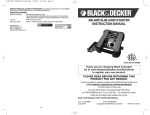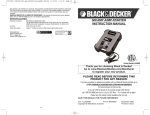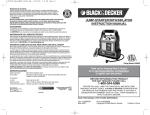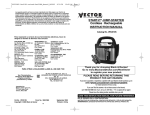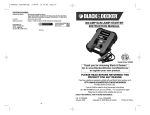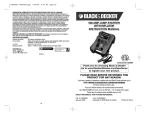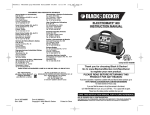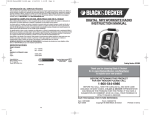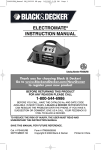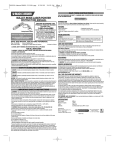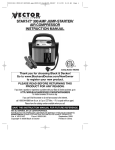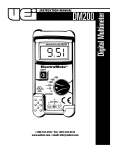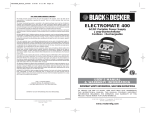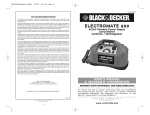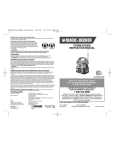Download Black & Decker ELECTROMATE 500 User's Manual
Transcript
BPS500B ManualENSP 041008.qxp 4/10/2008 10:42 AM Page 16 Esta garantía no se extiende a los accesorios. Esta garantía le concede derechos legales específicos; usted puede tener otros derechos que pueden variar según el estado o la provincia. Si tiene alguna pregunta, comuníquese con el Centro de mantenimiento de Black & Decker más cercano. Este producto no está diseñado para uso comercial. REEMPLAZO GRATUITO DE LAS ETIQUETAS DE ADVERTENCIA: Si las etiquetas de advertencia se tornan ilegibles o faltan, llame al 1-800-544-6986 para reemplazarlas gratuitamente. ESPECIFICACIONES Interruptor de transferencia: Unidad de UPS encendido (consumo de corriente sin carga): Tiempo de recarga: Especificaciones de la conversor Potencia de salida (continua máxima): Potencia de sobretensión (pico): Voltaje de salida (nominal): Frecuencia de salida: Forma de onda de salida: Especificaciones de CC de 12 voltios Tipo de batería interna: Capacidad de la batería interna: Voltaje de la batería interna: Alarma de batería baja: Apagado automático por batería baja: Corriente de carga del cargador interno: Puertos de carga USB Salida: 20 milisegundos ELECTROMATE® 500 INSTRUCTION MANUAL < 1,5 A (consumo de la batería) Aprox. 8 horas de 120 voltios de CA 500 W 1000 W 120 V de CA 60 Hz ± 2 Hz Onda senoidal modificada Plomo ácido AGM, sellada 40 amperios-hora 12 V de CC (nominal) 10,5 V (nominal) 10 V (nominal) Mayor de 5 amperios 5 voltios de CC 500 mA (máximo) Consulte las Páginas Amarillas para más información de servicio y ventas Importadod por Black & Decker (U.S.) Inc., 701 E. Joppa Rd. Towson, MD 21286 U.S.A. RD041008 Catalog Number BPS500B Thank you for choosing Black & Decker! Go to www.BlackandDecker.com/NewOwner to register your new product BEFORE RETURNING THIS PRODUCT FOR ANY REASON PLEASE CALL 1-800-544-6986 BEFORE YOU CALL, HAVE THE CATALOG No, AND DATE CODE AVAILABLE. IN MOST CASES, A BLACK & DECKER REPRESENTATIVE CAN RESOLVE THE PROBLEM OVER THE PHONE. IF YOU HAVE A SUGGESTION OR COMMENT, GIVE US A CALL. YOUR FEEDBACK IS VITAL TO BLACK & DECKER. SAVE THIS MANUAL FOR FUTURE REFERENCE. Cat. # BPS500B April 2008 16 Form # 90521846 Copyright © 2008 Black & Decker 1 Printed in China BPS500B ManualENSP 041008.qxp 4/10/2008 10:42 AM Page 2 SAFETY GUIDELINES / DEFINITIONS DANGER: Indicates an imminently hazardous situation which, if not avoided, will result in death or serious injury. WARNING: Indicates a potentially hazardous situation which, if not avoided, could result in death or serious injury. CAUTION: Indicates a potentially hazardous situation which, if not avoided, may result in minor or moderate injury. CAUTION: Used without the safety alert symbol indicates potentially hazardous situation which, if not avoided, may result in property damage. RISK OF UNSAFE OPERATION. When using UPS backup power, basic safety precautions should always be followed to reduce the risk of personal injury. Improper operation, maintenance or modification of UPS could result in serious injury and property damage. There are certain applications for which UPS is designed. Black & Decker strongly recommends that this product NOT be modified and/or used for any application other than for which it was designed. Read and understand all warnings and operating instructions before using UPS backup power. IMPORTANT SAFETY INSTRUCTIONS GENERAL SAFETY WARNINGS AND INSTRUCTIONS FOR ALL APPLIANCES READ ALL INSTRUCTIONS DANGER: RISK OF INJURY OR LOSS OF LIFE: DO NOT USE THIS UNIT IN CONNECTION TO LIFE SUPPORT SYSTEMS OR OTHER MEDICAL EQUIPMENT OR DEVICES. WARNING: Read all instructions before operating product. Failure to follow all instructions listed below may result in electric shock, fire and/or serious injury. • AVOID DANGEROUS ENVIRONMENTS: Don’t use UPS backup power in damp or wet locations. Don’t use UPS in the rain. • DON’T ABUSE CORD. Never carry UPS by cord or yank it to disconnect from receptacle. Keep cord from heat, oil, and sharp edges. WARNING: This product or its power cord contains lead, a chemical known to the State of California to cause cancer and birth defect or other reproductive harm. Wash hands after handling. WARNING: SHOCK HAZARD: • If an extension cord is used, make sure that: a) the pins of extension cord are the same number, size and shape as those in the unit, b) the extension cord is properly wired and in good electrical condition, • Do not operate unit with damaged cord or plug; or if the unit has received a sharp blow, been dropped, or otherwise damaged in any way. Do not disassemble the unit; take it to a qualified service technician when service or repair is required. Incorrect reassembly may result in a risk of electric shock or fire, and will void warranty. • Use of an attachment not supplied, recommended or sold by manufacturer specifically for use with this unit may result in a risk of electrical shock and injury to persons. • NEVER IMMERSE THIS UNIT IN WATER; do not expose it to rain, snow or use when wet. • To reduce risk of electric shock, disconnect the unit from any power source before attempting maintenance or cleaning. Turning off controls without disconnecting will not reduce this risk. WARNING: EXPLOSION HAZARD: • DO NOT use the UPS near flammable materials or in locations that may accumulate flammable fumes or gases. BATTERY CAUTIONS: • A battery can present a risk of electrical shock or burn from high short circuit current. Observe proper precautions. • Proper disposal of batteries is required. Refer to your local codes for disposal requirements. CAUTION: UPS is intended for installation in a temperature-controlled, indoor area, free of conductive contaminants. The unit should only be operated in locations that are: DRY — Do not allow water or other liquids to come into contact with the UPS. COOL — Surrounding air temperature should ideally be 0-35°C (32-95°F). Keep the UPS away from direct sunlight, when possible. WELL-VENTILATED — Keep the area surrounding the UPS clear to ensure free air circulation around the unit. Do not place items on or over the unit during operation. SAFE — Do not use the unit near flammable materials or in any locations that may accumulate flammable fumes or gases. This is an electrical appliance that can briefly spark when electrical connections are made or broken. CAUTION: TO REDUCE THE RISK OF INJURY OR PROPERTY DAMAGE: • THIS UNIT IS NOT FOR USE BY CHILDREN AND SHOULD ONLY BE OPERATED BY ADULTS. • DO NOT install in compartments containing batteries or flammable materials. • Use this unit in properly ventilated areas ONLY. Do not block ventilation slots. 2 • Do not open — there are no user-serviceable parts inside. • Do not insert foreign objects into the outlets. • This unit has not been tested for use with medical devices. • DO NOT expose to extreme heat or flames. • Check unit periodically for wear and tear. Call customer service for replacement of worn or defective parts immediately. FIRST AID – LCD LIQUID CRYSTAL DISPLAY: If liquid crystal comes in contact with your skin: Wash area off completely with plenty of water. Remove contaminated clothing. If liquid crystal gets into your eye: Flush the affected eye with clean water and then seek medical attention. If liquid crystal is swallowed: Flush your mouth thoroughly with water. Drink large quantities of water and induce vomiting. Then seek medical attention. CAUTION: TO REDUCE THE RISK OF DAMAGE TO THE UNIT: • Although this unit contains a non-spillable battery, it is recommended that unit be kept upright during storage, use and recharging. To avoid possible damage that may shorten the unit’s working life, protect it from direct sunlight, direct heat and/or moisture. • The unit will not work when connected to any AC load that has its neutral conductor connected to ground. Such loads include AC distribution wiring and house wiring. • Do not plug surge-protected power bars into the unit’s 120V AC outlets. • Do not connect an AC power source to the 120V AC outlets. • Do not connect the unit’s AC power cord to its 120V AC outlets. CAUTION: TO REDUCE THE RISK OF DAMAGING RECHARGEABLE APPLIANCES: Most rechargeable battery-operated appliances use a separate charger or transformer that plugs directly into an AC receptacle and produces a low voltage charging output. However, some chargers for rechargeable batteries can be damaged if connected to this unit. • Do not use small battery-operated appliances like flashlights, razors and night lights that can be plugged directly into an AC receptacle to recharge with this unit. • Do not use this unit with chargers for battery packs used in hand power tools displaying a warning label stating that dangerous voltages are present at the battery terminals. Note: When this unit is supplying backup power from its batteries, its output is a non-sinusoidal modified sine wave, which is different from pure sine wave utility-supplied electricity. Certain types of load equipment may be damaged. If you are unsure about using your rechargeable appliance with this unit, contact the appliance manufacturer to determine its compatibility with the modified sine wave (non-sinusoidal) AC wave form. IMPORTANT: • This unit is delivered in a partially charged state. Charge unit for a full 24 hours before using the unit’s internal backup power for the first time. • The unit can be turned ON and connected to an AC wall outlet continuously to maintain full internal battery charge. Once the unit is fully charged, the built-in charger will go into flow (stand-by) mode and will resume charging to top off the battery whenever the battery voltage drops (approximately 85% of battery capacity). Read And Understand This Instruction Manual Before Using This Unit. SAVE THESE INSTRUCTIONS THIS MANUAL CONTAINS IMPORTANT SAFETY AND OPERATING INSTRUCTIONS FOR THE BLACK & DECKER® ELECTROMATE® 500 MODEL BPS500B THAT SHOULD BE FOLLOWED DURING INSTALLATION AND MAINTENANCE OF THE UPS AND BATTERIES. WARNING: TO REDUCE THE RISK OF INJURY: Follow these instructions and those published by the manufacturer of any equipment you intend to use with this unit. Review cautionary markings on these products. This device complies with part 15 of the FCC rules. Operation is subject to the following two conditions: (1) This device may not cause harmful interference, and (2) This device must accept any interference received, including interference that may cause undesired operation. This equipment has been tested and found to comply with the limits for a Class B digital device, pursuant to part 15 of the FCC Rules, These limits are designed to provide reasonable protection against harmful interference to radio communications. However, there is not guarantee that interference to radio or television reception, with can be determined by turning the equipment off and on, user is encouraged to try to connect the interference by one or more of the following measures: • Reorient or relocate the receiving antenna. • Increase the separation between equipment and receiver. • Connect equipment into an outlet on a circuit different from that to which the receiver is connected. • Consult the dealer or an experienced radio/TV technician for help. 3 BPS500B ManualENSP 041008.qxp 4/10/2008 10:42 AM Page 4 INTRODUCTION LCD DISPLAY Thank you for choosing the Black & Decker® Electromate® 500. Please read this guide carefully before use to ensure optimum performance and avoid damage to the unit or items that you are using it with. The LCD Display should be on continuously when the unit is turned ON and either connected to a power source or charged and operating as a power backup. The LCD Display shows battery charge level, battery voltage, wattage in use and wattage available. It also automatically displays any fault conditions that may occur (refer to the “Troubleshooting” section for more information). FEATURES • Built-in 500 Watt Ups • 6 120 Volt AC Household Power Outlets • 2 USB Charging Ports to power and/or recharge USB personal devices • Status message LCD Display • Battery Status Icon AC Icon Protective Features • Automatic Overload: Built-in protection against overload — in the event the AC outlet draws more than 500 watts, power to the unit’s outlet will automatically shut off. • Low Battery: If the battery power level is too low, the AC Power Supply shuts down automatically. The LCD Display also shows when the unit is turned ON and operating on its internal battery. The AC Icon (see illustration) will show when the unit is connected to a functioning 120 volt AC power source . If the AC Icon does not display, the unit is either disconnected from a power source or a power outage has occurred and any appliances plugged into the unit are operating on the unit’s internal battery. USING THE 120 VOLT AC POWER SUPPLY AC ICON AC Power Supply Controls, Indicators and Operation Controls and Indicators LCD DISPLAY POWER ON/OFF PUSHBUTTON DISPLAY PUSHBUTTON The ON/OFF Pushbutton turns the unit ON and OFF. It can also be used to reset power after shutdown due to overvoltage, overload or short-circuit condition. 1. Press the ON/OFF Switch to turn the unit ON. “ELECTROMATE 500” will scroll across the LCD Display. 2. Plug the 110/120 volt AC appliance into one of the unit’s 120 Volt AC Outlets and operate normally. 3. Monitor power usage to assure that you don’t overload the unit. Ensure that the wattage of all equipment simultaneously plugged into the unit’s 120 Volt AC Outlets does not exceed 500 watts continuous. Note: This unit’s 120 Volt AC Outlets will not operate appliances and equipment that generate heat, such as hair dryers, electric blankets, microwave ovens and toasters. USING THE USB CHARGING PORTS USB Power Supply Controls, Indicators and Operation USB CHARGING PORTS The ON/OFF Pushbutton turns the unit ON and OFF. It can also be used to reset power after shutdown due to overvoltage, overload or short-circuit condition. 1. Plug the USB device into one of the unit’s USB Ports and operate normally. 2. Monitor power usage to assure that you don’t overload the unit. Note: This unit’s USB Charging Ports do not support data communication. They only provide 5 volts/500mA DC power (max) to external USB-powered devices. 120 VOLT AC OUTLETS MONITORING POWER USAGE PREPARING THE UNIT FOR FIRST USE This unit is delivered in a partially charged state – you must fully charge this unit before using its internal backup power for the first time. Initial AC charge should be for 24 hours. Subsequent charges should be for 8 hours. Follow the directions in the following section. CHARGING/RECHARGING THE UNIT For maximum battery life, we recommend the unit be kept fully charged at all times. If the battery is allowed to remain in a discharged state, battery life will be shortened. • FULLY CHARGE THE UNIT BY PLUGGING IT INTO A STANDARD NORTH AMERICAN 120 VOLT OUTLET AND PRESSING THE MAIN POWER PUSHBUTTON TO TURN THE UNIT “ON.” The LCD display will show "CHARGING" if there is no load connected to the AC outlets and " FULLY CHARGED" when battery is full, if there is load connected to the AC outlet you can also monitor the charging progress by referring to the battery icon (see next section). • Recharge the unit fully after each use. • Recharge the unit every two months when it has not been used regularly. Notes: Recharging the battery after each use prolongs battery life; frequent discharges between recharges reduces battery life. The unit cannot be overcharged. Viewing Battery Charge Status Battery Status Icon (see illustration) is located on the LCD DIsplay. When the full icon displays, the unit is fully charged. As power is used, the Icon displays partially (fading from right to left), similar to the charge bars on a cell phone. This Icon will blink while the unit is charging, and display completely once again when the unit is returned to full charge. 4 1. While the unit is initially turned ON, the wattage in use will show on the LCD Display for approximately 3 seconds (for example, if you have plugged in an appliance that draws 200 watts, “200 WAT” will show). After 3 seconds, the wattage in use followed by the remaining wattage available will scroll (for example, “100 WATT IN USE, 400 WATT AVAILABLE”). 2. Pressing the Display Button shows the voltage in use (for example, “110 VOLT AC”). 3. Pressing the Display Button a second time shows the unit’s Battery Voltage. Monitoring battery voltage is useful for determing when to recharge the unit to avoid a Low Battery Fault shutdown. Make sure the 120 Volt AC Power Supply is turned OFF when the unit is being stored. The standard North American 120 volt AC and USB outlets allow simultaneous operation of multiple devices. Simply plug the equipment into the unit and operate normally. Ensure that the wattage of all equipment simultaneously plugged into the BPS500B does not exceed 500 watts continuous. Notes: The power supply shuts down automatically when a fault condition such as an overload, overheating or short circuiting or battery level drop has occurred. Refer to the “Troubleshooting” section for a list of fault conditions and suggested remedies. USING THE BACKUP POWER FEATURE The unit’s six 120 Volt AC Outlets are permanently backed up by the internal battery. During a power outage or other utility problem (such as brownouts and over-voltages), the unit will keep running the connected products for up to 8 hours, depending on the power draw of the appliances. When utility power is restored, the unit automatically reverts to AC home power and Charging/Recharging Mode. Note: When connected to utility power, the unit automatically provides AC power from its internal battery in the event that utility voltage falls outside the 105–135 volt AC range. BATTERY STATUS ICON 5 BPS500B ManualENSP 041008.qxp 4/10/2008 10:42 AM Page 6 SAMPLE RUN TIMES Appliance Watts* Run Time** Product Watts* Run Time** Laptop computer 30 12 h Table lamp 40 9h Inkjet printer 20 16 h Desktop computer 70 5h Cordless phone 5 74 h 17" LCD monitor 35 10 h Cell Phone 5 74 h 13" TV 50 7h Internet modem 10 35 h Clock radio 6 62 h Should the battery need replacing, it is recommended that the unit be returned to manufacturer for battery replacement. Contact Customer Service, toll-free, at (800) 544-6986. This unit contains a maintenance-free, sealed, non-spillable, lead acid battery, which must be disposed of properly. Recycling is required — contact your local authority for information. Failure to comply with local, state and federal regulations can result in fines or imprisonment. For more information on recycling this battery, call toll-free (800) 822-8837. WARNINGS • Do not dispose of product in fire as batteries inside this product may explode or leak. • Do not expose the unit containing a battery to fire or intense heat as it may explode. Combination of Appliances Run Time** SERVICE INFORMATION Laptop, cordless phone, Internet modem/router 13" TV, cell phone charger, table lamp up to 8 h.5 up to 4 h Desktop computer, 15" LCD monitor, inkjet printer, Internet modem, cordless phone, table lamp up to 2 h.5 * Rated power may differ from appliance’s actual average power consumption. ** Run times are based on loads tested under regular operating conditions and are approximate. All Black & Decker Service Centers are staffed with trained personnel to provide customers with efficient and reliable power tool service. Whether you need technical advice, repair, or genuine factory replacement parts, contact the Black & Decker location nearest you. To find your local service location, refer to the yellow page directory under "Tools—Electric" or call: 1-800-5446986 or visit www.blackanddecker.com. CAUTION If the cord becomes damaged, return the entire unit to manufacturer immediately for service/repair. TROUBLESHOOTING FULL ONE-YEAR HOME USE WARRANTY General Problem The unit will not power ON Solution • Connect the unit’s power cord to the wall outlet securely • Make sure that the internal battery is charged (check the Battery Status Icon on the LCD Display). If charge is low, recharge the battery. If battery will not accept a charge after 24 hours, refer to the “Service Information” section. Appliances connected to unit lose power A fault condition is present. Check the LCD Display for fault condition message and take the appropriate action (refer to the Fault Condition chart that follows). Appliances connected to unit malfunction or overheat Appliances connected to the unit do not accept modified sine wave form. Refer to “CAUTION: TO REDUCE THE RISK OF DAMAGING RECHARGEABLE APPLIANCES” on page 3. Inadequate run time Make sure that the internal battery is charged (check the Battery Status Icon on the LCD Display). If charge is low, recharge the battery. If battery will not accept a charge after 24 hours, refer to the “Service Information” section. Fault Conditions Following is a list of fault conditions, the corresponding LCD Display messages and recommended remedies. LCD Message Fault Condition Recommended Remedy OVERLOAD Shows when an overload condition exists (total wattage draw exceeds 500 watts) or appliances connected to unit have a surge power that exceeds 500 watts. Shows when an appliance that is plugged into the unit is short-circuited. Reduce load to 500 watts (continuous). Manually reset unit by pressing ON/OFF Pushbutton OFF, then ON again. SHORT CIRCUIT PROTECTION LOW BAT Unplug the appliance from the unit and take appliance to a qualified technician for repair. Manually reset unit by pressing ON/OFF Pushbutton OFF, then ON again. LOW BATTERY WARNING. Shows when Disconnect load. Recharge battery (refer to the unit’s battery charge level drops below 10.5 “Charging/ Recharging the Unit”). volts. An audible will sound. CARE AND MAINTENANCE Storage 1. Ideal storage temperature range is 0-25°C (32-77°F). 2. Store and use the unit in a cool, dry place with adequate ventilation for all-around air circulation. 3. Avoid locations that are exposed to heating units, radiators, direct sunlight, or excessive humidity or dampness. Black & Decker (U.S.) Inc. warrants this product for one year against any defects in material or workmanship. The defective product will be replaced or repaired at no charge in either of two ways. The first, which will result in exchanges only, is to return the product to the retailer from whom it was purchased (provided that the store is a participating retailer). Returns should be made within the time period of the retailer’s policy for exchanges (usually 30 to 90 days after the sale). Proof of purchase may be required. Please check with the retailer for their specific return policy regarding returns that are beyond the time set for exchanges. The second option is to take or send the product (prepaid) to a Black & Decker owned or authorized Service Center for repair or replacement at our option. Proof of purchase may be required. Black & Decker owned and authorized Service Centers are listed under "Tools-Electric" in the yellow pages of the phone directory and on our website www.blackanddecker.com. This warranty does not apply to accessories. This warranty gives you specific legal rights and you may have other rights which vary from state to state or province to province. Should you have any questions, contact the manager of your nearest Black & Decker Service Center. This product is not intended for commercial use. FREE WARNING LABEL REPLACEMENT: If your warning labels become illegible or are missing, call 1-800-544-6986 for a free replacement. SPECIFICATIONS Transfer Switch: UPS On (no-load current draw): Recharging Time: Inverter Specifications Output Power (max. continuous): Surge Power (peak): Output Voltage (nominal): Output Frequency: Output Wave Form: 12 Volt DC Specifications Internal Battery Type: Internal Battery Capacity: Internal Battery Voltage: Low Battery Alarm: Low Battery Shutdown: Internal Charger Charging Current: USB Charging Ports Output: 20 milliseconds < 1.5 A (battery drain) Approx. 8 hours from 120V AC 500 W 1000 W 120V AC 60 Hz ±2 Hz Modified sine wave Sealed lead acid, AGM 40 amp-hours 12 VDC (nominal) 10.5 V (nominal) 10.0 V (nominal) 6 A DC (max.) Greater than 5 amps See ‘Tools-Electric’ – Yellow Pages – for Service & Sales Imported by Black & Decker (U.S.) Inc., 701 E. Joppa Rd. Towson, MD 21286 U.S.A. RD041008 Battery Replacement/Disposal This product has a sealed lead acid battery that should be kept fully charged. Charge before first use, immediately after each use, and once every two months if not used regularly. Failure to do this may reduce the battery life dramatically. 6 7 BPS500B ManualENSP 041008.qxp 4/10/2008 10:42 AM Page 8 MANUAL DE INSTRUCCIONES DEL ELECTROMATE® 500 Número de catálogo BPS500B ¡Gracias por elegir Black & Decker! Vaya a www.BlackandDecker.com/NewOwner para registrar su nuevo producto. ANTES DE DEVOLVER ESTE PRODUCTO POR CUALQUIER MOTIVO, LLAME AL 1-800-544-6986 ANTES DE LLAMAR, TENGA A MANO EL N.º DE CATÁLOGO Y EL CÓDIGO DE LA FECHA. EN LA MAYORÍA DE LOS CASOS, UN REPRESENTANTE DE BLACK & DECKER PODRÁ SOLUCIONAR SU PROBLEMA POR TELÉFONO. SI DESEA REALIZAR UNA SUGERENCIA O COMENTARIO, LLÁMENOS, SU OPINIÓN ES FUNDAMENTAL PARA BLACK & DECKER. CONSERVE ESTE MANUAL PARA FUTURAS CONSULTAS. N.º de catálogo BPS500B Abril 2008 8 N.º de formulario 90521846 Copyright © 2008 Black & Decker Impreso en China 9 BPS500B ManualENSP 041008.qxp 4/10/2008 10:42 AM Page 10 NORMAS DE SEGURIDAD/DEFINICIONES PELIGRO: Indica una situación de peligro inminente que, si no se evita, provocará la muerte o lesiones graves. ADVERTENCIA: Indica una situación de peligro potencial que, si no se evita, podría provocar la muerte o lesiones graves. PRECAUCIÓN: Indica una situación de peligro potencial que, si no se evita, provocará lesiones leves o moderadas. PRECAUCIÓN: Cuando se utiliza sin el símbolo de alerta de seguridad indica una situación de peligro potencial que, si no se evita, puede provocar daños a la propiedad. RIESGO DE OPERACIÓN INSEGURA. Al usar energía de reserva de la UPS, las medidas de seguridad básicas se deben seguir siempre para reducir el riesgo de los daños corporales. La operación, el mantenimiento o la modificación incorrecto de la UPS podían dar lugar a lesión y a daños materiales serios. Hay ciertos usos para los cuales se diseña la UPS. El negro y Decker recomienda fuertemente que este producto para no ser modificado y/o para no ser utilizado para cualquier uso con excepción de para cuál fue diseñada. Lea y entienda todas las advertencias e instrucciones de funcionamiento antes de usar energía de la reserva de la UPS. INSTRUCCIONES IMPORTANTES SOBRE SEGURIDAD PELIGRO: RIESGO DE LESIONES O MUERTE: NO CONECTE SISTEMAS DE SOPORTE VITAL U OTROS EQUIPOS O DISPOSITIVOS MÉDICOS A ESTA UNIDAD. INSTRUCCIONES GENERALES Y ADVERTENCIAS DE SEGURIDAD PARA TODOS LOS ARTEFACTOS LEA TODAS LAS INSTRUCCIONES ADVERTENCIA: Lea todas las instrucciones antes de operar el UPS. El incumplimiento de todas las instrucciones enumeradas a continuación puede provocar una descarga eléctrica, un incendio o lesiones graves. • EVITE LAS CONDICIONES AMBIENTALES PELIGROSAS: No utilice energía de la reserva de la UPS en zonas húmedas o mojadas. No utilice la UPS bajo la lluvia. • NO TIRE DEL CABLE. Nunca transporte la UPS por el cable ni lo jale para desconectarlo del tomacorriente. Mantenga el cable alejado del calor, el aceite y los bordes afilados. ADVERTENCIA: Este producto o su cable de alimentación contiene plomo, una sustancia química reconocida por el Estado de California como causante de cáncer, defectos de nacimiento u otros problemas reproductivos. Lávese las manos después de utilizarlo. ADVERTENCIA: RIESGO DE DESCARGA ELÉCTRICA: • Si es necesario utilizar un cable prolongador, asegúrese de que: a) las patas del cable prolongador sean de la misma cantidad, el mismo tamaño y la misma forma que las de la unidad, b) el cable prolongador posea los conductores correctos y esté en buenas condiciones eléctricas, • No opere la unidad con un cable o enchufe dañados, o si ésta ha recibido un golpe fuerte, se cayó o presenta algún daño. No desarme la unidad; llévela a un técnico de servicio calificado cuando se requiera mantenimiento o una reparación. Volver a armarla de manera incorrecta podría provocar un riesgo de descarga eléctrica o un incendio, y anulará la garantía. • El uso de un dispositivo no suministrado, recomendado o vendido por el fabricante específicamente para el uso con esta unidad puede provocar riego de descarga eléctrica y lesiones a las personas. • NUNCA SUMERJA ESTA UNIDAD EN AGUA; no la exponga a la lluvia o la nieve, ni la utilice cuando esté mojada. • Para reducir el riesgo de descarga eléctrica, desconecte la unidad de cualquier fuente de energía antes de intentar limpiarla o realizarle un mantenimiento. Apagar los controles sin desenchufar la unidad no reducirá este riesgo. ADVERTENCIA: PELIGRO DE EXPLOSIÓN: • NO utilice la USB cerca de materiales inflamables o en lugares donde se puedan acumular vapores o gases inflamables. PRECAUCIONES DE LA BATERÍA: • Una batería puede presentar un riesgo del choque eléctrico o quemarse de alta corriente del cortocircuito. Observe las precauciones apropiadas. • La disposición apropiada de baterías se requiere. Refiera a sus códigos locales para los requisitos de la disposición. PRECAUCIÓN: La UPS se piensa para la instalación en un área de temperatura controlada, de interior, libera de contaminantes conductores. La unidad sólo debe utilizarse en lugares que sean: SECOS: No permita que el agua u otros líquidos entren en contacto con la unidad de UPS. FRESCOS: La temperatura ambiente debe estar entre 0 °C y 35 °C (32 °F y 95 °F). Mantenga la unidad de UPS lejos de la luz solar directa siempre que sea posible. BIEN VENTILADOS: Mantenga el área que rodea la unidad de UPS limpia para garantizar la libre circulación de aire alrededor de la unidad. No coloque artículos sobre la unidad o por encima de ésta durante su funcionamiento. 10 SEGUROS: No utilice la unidad cerca de materiales inflamables o en lugares donde se puedan acumular vapores o gases inflamables. Es un aparato eléctrico que puede generar chispas durante breves períodos si se establecen conexiones eléctricas o éstas se rompen. PRECAUCIÓN: PARA REDUCIR EL RIESGO DE LESIONES O DAÑO A LA PROPIEDAD: • LOS NIÑOS NO DEBEN UTILIZAR ESTA UNIDAD. SÓLO LOS ADULTOS PUEDEN OPERARLA. • NO lo instale en compartimientos que contienen baterías o materiales inflamables. • Use esta unidad SOLAMENTE en áreas con una buena ventilación. No bloquee las ranuras de ventilación. • No la abra: no hay piezas que el usuario pueda reparar en su interior. • No introduzca objetos extraños en el tomacorriente. • Esta unidad no ha sido probada para su uso con dispositivos médicos. • NO lo exponga al calor extremo o a las llamas. • Controle el desgaste de la unidad periódicamente. Llame el servicio de cliente para el reemplazo de piezas gastadas o defectuosas inmediatamente. PRIMEROS AUXILIOS – PANTALLA DE CRISTAL LÍQUIDO (LCD): Si el cristal líquido entra en contacto con el pie, lave el área por completo con mucha agua. Retire la ropa contaminada. Si el cristal líquido entra en contacto con los ojos, enjuague el ojo afectado con agua limpia y luego busque atención médica. Si ingiere cristal líquido, enjuague la boca cuidadosamente con agua. Beba abundante cantidad de agua e induzca el vómito. A continuación, busque asistencia médica de inmediato. PRECAUCIÓN: PARA EVITAR DAÑOS A LA UNIDAD: • Si bien esta unidad contiene una batería que no derrama, se recomienda que la unidad se conserve parada durante el almacenamiento, el uso y la recarga. Para evitar daños posibles que puedan acortar la duración de la unidad, protéjala de la luz solar directa, el calor directo o la humedad. • La unidad no funcionará si se conecta a una carga de CA con conductor neutro conectado a tierra. Tales cargas incluyen cableado doméstico y cableado de distribución de CA. • No enchufe barras de corriente eléctrica protegidas contra sobretensiones en los tomacorrientes de 120 V de CA de la unidad. • No conecte una fuente de energía de CA a los tomacorrientes de 120 V de CA. • No conecte el cable de alimentación de CA de la unidad a sus tomacorrientes de 120 V de CA. PRECAUCIÓN: PARA DISMINUIR EL RIESGO DE DAÑAR APARATOS RECARGABLES: La mayoría de los aparatos recargables operados con baterías utilizan un cargador o transformador independiente que se enchufa directamente en un tomacorriente de CA y produce una baja salida de voltaje de carga. Sin embargo, algunos cargadores para baterías recargables pueden dañarse si se conectan a esta unidad. • No utilice aparatos pequeños operados con batería, como linternas, afeitadoras y veladores que puedan enchufarse directamente a un tomacorriente de CA para recargarse con esta unidad. • No utilice esta unidad con los cargadores de paquetes de baterías utilizados en herramientas eléctricas manuales que exhiben una etiqueta de advertencia indicando la presencia de voltajes peligrosos en los terminales de la batería. Nota: Cuando esta unidad proporciona energía de respaldo con sus baterías, la salida es una onda senoidal modificada no sinusoidal, que es diferente a la electricidad en ondas senoidales puras del suministro público. Algunos equipos de carga pueden dañarse. Si no está seguro de poder utilizar un aparato recargable con esta unidad, comuníquese con el fabricante del aparato para determinar la compatibilidad con las ondas senoidales modificadas (no sinusoidales) de CA. IMPORTANTE: • Esta unidad se entrega en un estado de carga parcial. Cargue la unidad completamente durante 24 horas antes de utilizar por primera vez la energía de respaldo interna de la unidad. • La unidad puede encenderse y conectarse a un tomacorriente de pared de CA, para mantener la carga completa de la batería interna. Una vez que la unidad esté totalmente cargada, el cargador incorporado entrará en modo flujo (de espera) y seguirá cargando la batería hasta completar la carga cuando el voltaje de la batería disminuya (aproximadamente el 85% de la capacidad de la batería). Lea y comprenda este manual de instrucciones antes de utilizar esta unidad. CONSERVE ESTAS INSTRUCCIONES ESTE MANUAL CONTIENE LAS INSTRUCCIONES IMPORTANTES DE SEGURIDAD Y DE FUNCIONAMIENTO PARA EL NEGRO Y EL DECKER® ELECTROMATE® 500 BPS500B MODELO QUE SE DEBEN SEGUIR DURANTE LA INSTALACIÓN Y EL MANTENIMIENTO DE LA UPS Y DE LAS BATERÍAS. ADVERTENCIA: PARA REDUCIR EL RIESGO DE LESIONES: • Siga estas instrucciones y las publicadas por el fabricante de cualquier equipo que tenga la intención de utilizar con esta unidad. Revise las señales de advertencia de estos productos. 11 BPS500B ManualENSP 041008.qxp 4/10/2008 10:42 AM Page 12 Este dispositivo cumple con la parte 15 de las normas de la Comisión Federal de Comunicaciones de Estados Unidos (FCC). La operación está sujeta a las dos condiciones siguientes: (1) este dispositivo no puede causar interferencia perjudicial y (2) este mecanismo debe aceptar cualquier interferencia recibida, incluida la interferencia que puede provocar una operación no deseada. Este equipo ha sido probado y se encontró que cumple con los límites para dispositivo digital Clase B, según la parte 15 de las normas de la FCC. Estos límites están diseñados para brindar protección razonable contra interferencia perjudicial en una instalación residencial. Este equipo genera, usa y puede irradiar energía en frecuencia de radio y, si no se instala y se usa de acuerdo con las instrucciones, puede provocar interferencia perjudicial en las comunicaciones de radio. Sin embargo, no hay garantía de que la interferencia no ocurra en una instalación en particular. Si el equipo provoca interferencia perjudicial en la recepción de radio o televisión, lo que se puede determinar al apagar y encender el equipo, el usuario debe tratar de corregir la interferencia mediante una o más de las siguientes medidas: • Cambiar la orientación o la ubicación de la antena de recepción. • Aumentar la separación entre el equipo y el receptor. • Conectar el equipo a un tomacorriente sobre un circuito diferente de aquel al que está conectado el receptor. • Consultar al vendedor o pedir la ayuda de un técnico en radio y televisión con experiencia. INTRODUCCIÓN Gracias por elegir Electromate® 500 de Black & Decker®. Por favor lea esta guía cuidadosamente antes de usar la unidad para asegurarse el rendimiento óptimo de la misma y evitar daños a la unidad o a los artículos con los cuales la está usando. La exhibición del LCD demostrará la "CARGA" si no hay carga conectada con los enchufes de la CA y "CARGADO COMPLETAMENTE" cuando la batería es llena, si hay carga conectada con el enchufe de la CA usted puede también supervisa el progreso de carga refiriendo al icono de la batería (véase la sección siguiente). • Vuelva a cargar la unidad completamente después de cada uso. • Vuelva a cargar la unidad cada dos meses si no se ha utilizado regularmente. Notas: Recargar la batería después de cada uso prolonga la duración de la batería; las descargas frecuentes entre las recargas reducen la duración de la batería. La unidad no puede sobrecargarse. Visualización del estado de carga de la batería El icono de estado de la batería (consulte la ilustración) se encuentra en la pantalla LCD. Cuando aparece el icono completo, la unidad está completamente cargada. A medida que se consume la energía, el icono aparece en forma parcial (se apaga de derecha a izquierda), como las barras de carga de un teléfono celular. El icono titila cuando la unidad se carga y se aparece nuevamente cuando la unidad está completamente cargada. ICONO DE ESTADO DE LA BATERÍA PANTALLA LCD La pantalla LCD debe permanecer encendida si la unidad está encendida y, además, está conectada a una fuente de energía o está cargada y funcionando como energía de respaldo. La pantalla LCD muestra el nivel de carga de la batería, el voltaje de la batería, la potencia en vatios en uso y la potencia en vatios disponible. También muestra automáticamente cualquier condición de falla posible (consulte la sección “Detección de problemas” para obtener más información). CARACTERÍSTICAS • Conversor de 500 vatios incorporado • 6 tomacorrientes de uso doméstico de 120 voltios de CA • 2 puertos de carga USB para alimentar o recargar dispositivos personales USB • Pantalla LCD para mensajes de estado • Icono de estado de la batería Icono de CA Características de protección • Sobrecarga automática: Protección incorporada contra sobrecarga; en el caso de que el tomacorriente de CA genere más de 500 vatios, la energía suministrada al tomacorriente de la unidad se apagará automáticamente. • Baja batería: Si el nivel de energía de la batería es demasiado bajo, la fuente de energía de CA se apaga automáticamente. Controles e indicadores La pantalla LCD también muestra cuando la unidad está encendida y funciona con su batería interna. El icono de AC (consulte la ilustración) se mostrará cuando la unidad esté conectada a una fuente de energía de 120 voltios de CA. Si no se muestra el icono de CA, la unidad está desconectada de la fuente de energía o hubo un corte eléctrico y los aparatos enchufados a la unidad están funcionando con la energía provista por la batería interna de la unidad. ICONO DE CA USO DE LA FUENTE DE ENERGÍA DE CA DE 120 VOLTIOS Controles, indicadores y funcionamiento de la fuente de energía de CA PANTALLA LCD BOTÓN ON/OFF (DE ENCENDIDO/APAGADO) BOTÓN "DISPLAY" (MOSTRAR) PUERTOS DE CARGA USB TOMACORRIENTES DE CA DE 120 VOLTIOS El botón ON/OFF (de encendido/apagado) enciende y apaga la unidad. También puede utilizarse para reiniciar la energía de CA después de que se haya apagado por una condición de voltaje excesivo, sobrecarga o cortocircuito. 1. Presione el interruptor ON/OFF (de encendido/apagado) para encender la unidad. El mensaje “ELECTROMATE 500” se desplazará por la pantalla LCD. 2. Enchufe el aparato de 110/120 voltios de CA en uno de los tomacorrientes de 120 voltios de CA y utilícelo normalmente. 3. Controle el consumo de energía para asegurarse de no sobrecargar la unidad. Asegúrese de que el vatiaje de todo el equipo tapado simultáneamente en los enchufes de la CA de 120 voltios de la unidad no exceda 500 vatios de continuo. Nota: Los tomacorrientes de 120 voltios de CA de esta unidad no servirán para aparatos y equipos que generen calor, como secadores de pelo, mantas térmicas, hornos de microondas y tostadores. USO DE LOS PUERTOS DE CARGA USB Controles, indicadores y funcionamiento de la fuente de energía USB PREPARACIÓN DE LA UNIDAD PARA EL PRIMER USO Esta unidad se entrega en un estado de carga parcial; debe cargar la unidad completamente antes de utilizar por primera vez la energía interna de respaldo. La carga inicial de CA debe ser de 24 horas. Las cargas sucesivas deben ser de 8 horas. Siga las indicaciones en la siguiente sección. CARGA Y RECARGA DE LA UNIDAD El botón ON/OFF (de encendido/apagado) enciende y apaga la unidad. También puede utilizarse para reiniciar la energía de CA después de que se haya apagado por una condición de voltaje excesivo, sobrecarga o cortocircuito. 1. Enchufe el aparato USB en uno de los puertos USB de la unidad y utilícelo normalmente. 2. Controle el consumo de energía para asegurarse de no sobrecargar la unidad. Nota: Los puertos de carga USB de esta unidad no admiten la comunicación de datos. Sólo proporcionan energía de 5 voltios y 500 mA de CC (máximo) a dispositivos eléctricos USB externos. CONTROL DEL CONSUMO DE ENERGÍA Para una duración máxima de la batería, recomendamos que la unidad se mantenga completamente cargada en todo momento. Si se permite que la batería permanezca descargada, se acortará su duración. • PARA CARGAR LA UNIDAD COMPLETAMENTE, ENCHÚFELA A UN TOMACORRIENTE ESTÁNDAR DE 120 VOLTIOS DE ESTADOS UNIDOS Y PRESIONE EL BOTÓN DE ENERGÍA PRINCIPAL PARA QUE LA UNIDAD SE ENCIENDA (“ON”). 1. Al encender la unidad, la potencia en vatios en uso se mostrará en la pantalla LCD por unos 3 segundos (por ejemplo, si tiene conectado un aparato que consume 200 vatios, se mostrará “200 WAT” [200 vatios]). Luego de 3 segundos, se mostrará la potencia en vatios en uso, seguida de la potencia en vatios disponible (por ejemplo, “100 WATT IN USE, 400 WATT AVAILABLE” [100 vatios en uso, 400 vatios disponibles]). 2. Al presionar el botón "Display" (mostrar) verá el voltaje en uso (por ejemplo, “110 VOLT AC” [110 voltios de CA]). 3. Al volver a presionar el botón "Display" verá el voltaje de la batería de la unidad. Controlar el voltaje de la batería sirve para determinar cuándo se debe recargar la unidad y así poder evitar el apagado por batería baja. 12 13 BPS500B ManualENSP 041008.qxp 4/10/2008 10:43 AM Page 14 Asegúrese de que la fuente de energía de 120 voltios de CA esté APAGADA cuando se almacene la unidad. Los tomacorrientes estándar USB y para CA de 120 voltios de Estados Unidos permiten el funcionamiento simultáneo de múltiples dispositivos. Simplemente enchufe el equipo en la unidad y utilícelo normalmente. Asegúrese de que la potencia en vatios de todos los equipos enchufados simultáneamente en el BPS500B no exceda los 500 vatios continuos. Notas: Al estar conectada al suministro público, la unidad proporciona automáticamente energía de CA de su batería interna si el voltaje del suministro público no está dentro de los 105 a 135 voltios de CA. TIEMPOS DE FUNCIONAMIENTO DE MUESTRA Los seis tomacorrientes de 120 voltios de CA ofrecen un respaldo continuo de la batería interna. En el caso de un corte eléctrico u otro problema con el suministro público (como un corte eléctrico parcial o voltaje excesivo), los productos conectados a la unidad seguirán funcionando durante hasta 8 horas, según el consumo de energía de los aparatos. Al restaurarse el suministro público, la unidad volverá a funcionar automáticamente con la energía de CA doméstica y en el modo de carga y recarga. Nota: Al estar conectada al suministro público, la unidad proporciona automáticamente energía de CA de su batería interna si el voltaje del suministro público no está dentro de los 105 a 135 voltios de CA. Condiciones de falla A continuación hay una lista de condiciones de falla, con el mensaje de la pantalla LCD y las soluciones recomendadas correspondientes. Mensaje de la pantalla LCD OVERLOAD (sobrecarga) SHORT CIRCUIT PROTECTION (protección del cortocircuito) Condición de falla Solución recomendada SSe muestra cuando existe una condición de sobrecarga (el consumo total de potencia en vatios supera los 500 vatios) o cuando los aparatos conectados a la unidad producen una potencia de sobretensión que supera los 500 vatios. Se muestra cuando un aparato enchufado a la unidad hizo un cortocircuito. Reduzca la carga a 500 vatios (continuos). Reinicie la unidad manualmente; para esto, presione el botón ON/OFF (de encendido/apagado) para apagarla y vuelva a presionarlo para encenderla. TIEMPOS DE FUNCIONAMIENTO DE MUESTRA Aparato Vatios* Tiempo de funcionamiento** Computadora portátil Impresora de tinta 30 20 12 h 16 h Teléfono inalámbrico Teléfono celular Modem 5 5 10 74 h 74 h 35 h Aparato Lámpara de escritorio Computadora de escritorio Monitor LCD de 17" TV de 13" Radio reloj Combinación de aparatos Vatios* Tiempo de funcionamiento** 40 70 9h 5h 35 50 6 10 h 7h 62 h Tiempo de funcionamiento** Computadora portátil, teléfono inalámbrico y módem hasta 8 h.5 TV de 13", lámpara de escritorio, cargador de celular hasta 4 h Computadora de escritorio, monitor LCD de 15", impresora tinta, módem, hasta 2 h.5 teléfono inalámbrico, lámpara de escritorio * La potencia clasificada puede ser diferente al consumo de energía promedio real del aparato. ** Los tiempos de funcionamiento son aproximados y están basados en las cargas probadas en condiciones normales de funcionamiento. DETECCIÓN DE PROBLEMAS General Problema Solución La unidad no se ENCIENDE • Conecte bien el cable de energía de la unidad al tomacorriente de pared • Asegúrese de que la batería interna esté cargada (verifique el icono de estado de la batería en la pantalla LCD). Si la carga es baja, vuelva a cargar la batería. Si la batería no acepta una carga después de 24 horas, consulte la sección “Información del servicio técnico”. Los aparatos conectados a la unidad dejan de recibir Existe una condición de falla. Observe la pantalla LCD para ver el corriente mensaje de condición de falla y poder tomar las medidas necesarias (consulte la siguiente tabla de Condiciones de falla). Los aparatos conectados a la unidad funcionan mal Los aparatos conectados a la unidad no pueden alimentarse con o se sobrecalientan ondas senoidales modificadas. Consulte “PRECAUCIÓN: PARA DISMINUIR EL RIESGO DE DAÑAR APARATOS RECARGABLES.” El tiempo de funcionamiento es inadecuado Asegúrese de que la batería interna esté cargada (verifique el icono de estado de la batería en la pantalla LCD). Si la carga es baja, vuelva a cargar la batería. Si la batería no acepta una carga después de 24 horas, consulte la sección “Información del servicio técnico”. 14 LOW BAT (batería baja) LOW BATTERY WARNING (advertencia de batería baja) Se muestra cuando el nivel de carga de la batería de la unidad disminuye por debajo de los 10,5 voltios. Se emitirá un sonido. Desenchufe el aparato de la unidad y lleve el aparato a un técnico calificado para que lo repare. Reinicie la unidad manualmente; para esto, presione el botón ON/OFF (de encendido/apagado) para apagarla y vuelva a presionarlo para encenderla. Desconecte la carga. Recargue la batería (consulte “Carga y recarga de la unidad”). CUIDADO Y MANTENIMIENTO Almacenamiento 1. Temperatura ideal de almacenamiento varía entre 0° C y 25 °C (32 °F y 77 °F). 2. Almacene y utilice la unidad en un lugar fresco y seco, con una ventilación adecuada que permita una buena circulación de aire. 3. Evite los lugares expuestos a unidades de calefacción, radiadores, luz solar directa o humedad en exceso. Reemplazo/Eliminación de la batería Este producto tiene una batería de plomo-ácido sellada que se debe mantener completamente cargada. Cárguela antes del primer uso, inmediatamente después de cada uso y cada dos meses si no se utiliza en forma regular. Si esto no se cumple la duración de la batería se reduce de manera muy importante. Si debe reemplazar la batería, se recomienda que devuelva la unidad al fabricante para que la reemplace. Para comunicarse con el Servicio de Atención al Cliente, llame a la línea gratuita (800) 544-6986. Esta unidad contiene una batería de plomo ácido sellada, que no derrama y no requiere mantenimiento, y que debe ser eliminada de la manera correcta. Se requiere reciclado: comuníquese con su autoridad local para obtener información. El incumplimiento de las reglamentaciones locales, estatales y federales pueden provocar multas o penas de prisión. Para obtener más información sobre cómo reciclar esta batería, llame a la línea gratuita (800) 822-8837. ADVERTENCIAS • No arroje el producto al fuego, ya que las baterías internas del producto pueden explotar o tener filtraciones. • No exponga la unidad que contiene la batería al fuego o a un calor intenso, porque puede explotar. INFORMACIÓN DEL SERVICIO TÉCNICO Todos los Centros de mantenimiento de Black & Decker cuentan con personal capacitado dispuesto a brindar a los clientes un servicio eficiente y confiable en la reparación de herramientas eléctricas. Si necesita consejo técnico, reparaciones o piezas de repuesto originales de fábrica, póngase en contacto con el Centro de Servicio de Black & Decker más cercano a su domicilio. Para localizar su centro de mantenimiento local, consulte "Herramientas eléctricas" (Tools-Electric) en la sección de páginas amarillas, llame al 1-800-544-6986 o visite www.blackanddecker.com. PRECAUCIÓN Si el cable se daña, devuelva la unidad completa al fabricante de inmediato, para su mantenimiento o reparación. GARANTÍA COMPLETA DE UN AÑO PARA USO EN EL HOGAR Black & Decker (Estados Unidos) Inc. ofrece una garantía de un año por cualquier defecto del material o de fabricación de este producto. El producto defectuoso se reparará o reemplazará sin costo alguno de dos maneras. La primera opción, el reemplazo, es devolver el producto al comercio donde se lo adquirió (siempre y cuando se trate de un comercio participante). Las devoluciones deben realizarse conforme a la política de devolución del comercio (generalmente, entre 30 y 90 días posteriores a la venta). Le pueden solicitar comprobante de compra. Consulte en el comercio acerca de la política especial sobre devoluciones una vez excedido el plazo establecido. La segunda opción es llevar o enviar el producto (con flete pago) a un Centro de mantenimiento propio o autorizado de Black & Decker para su reparación o reemplazo según nuestro criterio. Le pueden solicitar comprobante de compra. Encontrará una lista de los Centros de mantenimiento autorizados y de propiedad de Black & Decker bajo "Herramientas eléctricas" (Tools-Electric) en las páginas amarillas de la guía telefónica y también en nuestro sitio Web www.blackanddecker.com. 15
This document in other languages
- español: Black & Decker ELECTROMATE 500








